#j-1178
Text
Tier list of Cells at work neutrophils but it’s based on their likelihood to say fuck. J-1178 and the guy from illegal get the top tier for being canonically foul mouthed while 1196 and 1146 are too “big sibling mode” to even say heck.
31 notes
·
View notes
Text
If Walls Could Talk
If Walls Could Talk
https://ift.tt/J3Nqf56
by Tealybob
The Fat Lady had seen a great many things while living on the walls of Hogwarts. She’d seen students rise to glory, professors abuse their authority, and even a bonafide war that burned half of her wallmates.
But never had the Fat Lady seen something so complicated, so heart-aching, so amusing, and so unexpected as the interactions between the new Defense Against the Dark Arts professor and their new Headmistress.
Words: 1178, Chapters: 1/1, Language: English
Fandoms: Harry Potter - J. K. Rowling
Rating: Teen And Up Audiences
Warnings: No Archive Warnings Apply
Categories: F/M
Characters: Hermione Granger, Draco Malfoy, The Fat Lady (Harry Potter), Anne Boleyn Queen of England, Giffard Abbott
Relationships: Hermione Granger/Draco Malfoy, Hermione Granger & Draco Malfoy
Additional Tags: POV Third Person, Slow Burn, Professor Draco Malfoy, Headmistress Hermione Granger, Harry Potter Epilogue What Epilogue | EWE, Portraits, Moving Portraits (Harry Potter), Eavesdropping, gossipy portraits, Enemies to Lovers, Light-Hearted
via AO3 works tagged 'Hermione Granger/Draco Malfoy' https://ift.tt/AJOrSUN
March 28, 2024 at 06:20AM
7 notes
·
View notes
Text
Party at J's Gargoyle
read it on the AO3 at https://ift.tt/mQXeKsR
by NerdyLibrarian
Oracle notices Jason behaving in a worrying manner after he discovers the body of a missing child. Fortunately, the family of traumatized vigilantes has a system for handling nights like this. Cue the Party Protocol.
Words: 1178, Chapters: 1/1, Language: English
Fandoms: Batman - All Media Types, Batman: Under the Red Hood (2010)
Rating: General Audiences
Warnings: Creator Chose Not To Use Archive Warnings
Categories: Gen
Characters: Jason Todd, Barbara Gordon, Dick Grayson, Tim Drake, Duke Thomas, Stephanie Brown, Damian Wayne, Cassandra Cain, Bruce Wayne, Alfred Pennyworth
Relationships: Barbara Gordon & Jason Todd, Dick Grayson & Jason Todd, Tim Drake & Jason Todd, Jason Todd & Damian Wayne, Stephanie Brown & Jason Todd, Cassandra Cain & Jason Todd, Duke Thomas & Jason Todd, Alfred Pennyworth & Jason Todd, Jason Todd & Bruce Wayne, Batfamily Members & Jason Todd
Additional Tags: Depressed Jason Todd, Suicidal Thoughts, Past Character Death, that's jason, Referenced death of unnamed Alley child, Jason Todd Needs A Hug, BAMF Barbara Gordon, Good Sibling Dick Grayson, Good Sibling Tim Drake, Good Sibling Damian Wayne, Good Sibling Cassandra Cain, Good Sibling Stephanie Brown, Good Sibling Duke Thomas, Good Grandparent Alfred Pennyworth, Bruce Wayne is a Good Parent, Jason Todd Has PTSD, Suicidal Jason Todd
read it on the AO3 at https://ift.tt/mQXeKsR
2 notes
·
View notes
Photo

Xoïs
Xoïs (comme l'appelaient les Grecs) était une vaste cité antique située sur une île marécageuse au centre du delta du Nil en Égypte, l'actuelle Sakha. Elle fut fondée vers 3414-3100 av. J.-C. et fut habitée sans interruption jusqu'à l'apparition du christianisme vers 390 de notre ère. À l'époque de la cinquième dynastie d'Égypte (2498-2345 av. J.-C.), Xoïs était déjà considérée comme une ville antique. Elle servit de capitale de l'Égypte pendant le règne des Hyksos en Égypte et fut le site de la bataille cruciale entre Ramsès III (1186-1155 av. J.-C.) et les Peuples de la mer avec leurs alliés libyens en 1178 av. J.-C..
Lire la suite...
3 notes
·
View notes
Text
STEP 1: Choose a data set that you would like to work with.
After looking through the codebook for the GAPMINDER, I have decided that I am particularly interested in income per person. I will use variables in association like alcohol consumption per adult and suicide.
STEP 2, 3, 4 and 5. Identify a specific topic of interest - Prepare a codebook of your own - Identify a second topic that you would like to explore in terms of its association with your original topic - Add questions/items/variables documenting this second topic to your personal codebook.

STEP 6. Perform a literature review to see what research has been previously done on this topic.
El interés de este proyecto en los países de renta baja radica en que la investigación sobre el alcohol, sus alcances y sus perjuicios se ha limitado a un grupo de países de renta alta (Holmes, A., & Anderson, K., 2017; Walls H, Cook S, Matzopoulos R, et al, 2020)). También, se ha evidenciado un aumento de consumo de alcohol en los países de renta baja y media (Walls H, Cook S, Matzopoulos R, et al, 2020).
La revisión bibliográfica permitió relacionar diferentes estudios con la hipótesis del presente proyecto de investigación: Los países con menor renta per cápita presentan mayores tasas de consumo de alcohol y un mayor riesgo de suicidio.
En relación, Katherine J. Karriker-Jaffe, Sarah C. M. Roberts, and Jason Bond (2013) en su estudio Income Inequality, Alcohol Use, and Alcohol-Related Problems proponen que los índices de pobreza se asocian positivamente con el consumo ligero y excesivo, y los problemas relacionados con el alcohol.
También, en el estudio Lifetime income patterns and alcohol consumption: Investigating the association between long- and short-term income trajectories and drinking, Cerdá, M, Johnson-Lawrence, V.D. and Galea, S (2011) encontraron que los ingresos más bajos se asociaron con mayores probabilidades de abstinencia y de consumo excesivo de alcohol, en relación con el consumo ligero/moderado.
Además, el estudio Convergence in National Alcohol Consumption Patterns: New Global Indicators (2017) comparó el consumo per cápita con la renta real per cápita. Lo resultados sugieren que “la convergencia de la renta por sí sola (la aproximación gradual de los países en desarrollo a la renta per cápita de los países de renta alta) no conduce necesariamente a la convergencia de las pautas de consumo de alcohol basadas en los volúmenes per cápita”.
En relación con el riesgo de suicidio y el ingreso per cápita, el estudio Impact of Income Inequality and Other Social Determinants on Suicide Rate in Brazil (2015) evidenció que, entre otros, la desigualdad de ingresos es un factor de riesgo para las tasas de suicidio en dicho país. Además, subraya que, por ejemplo, la disminución de la desigualdad de renta y el aumento de la renta per cápita pueden contrarrestar el aumento de los suicidios en Brasil.
También relacionado, Zhang, J., Ma, J., Jia, C., Sun, J., Guo, X., Xu, A., & Li, W. (2010) con la investigación Economic growth and suicide rate changes: A case in China from 1982 to 2005, demostraron que el desarrollo económico está asociado a la disminución de las tasas de suicidio en China.
Referencias:
Cerdá, M, Johnson-Lawrence, V.D. and Galea, S (2011). Lifetime income patterns and alcohol consumption: Investigating the association between long- and short-term income trajectories and drinking. Social Science & Medicine. Volume 73, Issue 8. Pages 1178-1185, ISSN 0277-9536. https://doi.org/10.1016/j.socscimed.2011.07.025.
Cook, W.K., Bond, J. and Greenfield, T.K. (2014). Alcohol policies in LAMICs. Addiction, 109: 1081-1090. https://doi.org/10.1111/add.12571
Doran CM, Kinchin I (2020). Economic and epidemiological impact of youth suicide in countries with the highest human development index. PLoS ONE 15(5): e0232940. https://doi.org/10.1371/journal.pone.0232940
Holmes, A., & Anderson, K. (2017). Convergence in National Alcohol Consumption Patterns: New Global Indicators. Journal of Wine Economics, 12(2), 117-148. doi:10.1017/jwe.2017.15
Nobuyoshi Ishii, Takeshi Terao, Yasuo Araki, Kentaro Kohno, Yoshinori Mizokami, Masano Arasaki, Noboru Iwata. Risk factors for suicide in Japan: A model of predicting suicide in 2008 by risk factors of 2007, Journal of Affective Disorders, Volume 147, Issues 1–3, 2013, Pages 352-354, ISSN 0165-0327, https://doi.org/10.1016/j.jad.2012.11.038.
Katherine J. Karriker-Jaffe, Sarah C. M. Roberts, and Jason Bond (2013). Income Inequality, Alcohol Use, and Alcohol-Related Problems. American Journal of Public Health 103, 649-656, https://doi.org/10.2105/AJPH.2012.300882
Keyes, K.M. and Hasin, D.S. (2008), Socio-economic status and problem alcohol use: the positive relationship between income and the DSM-IV alcohol abuse diagnosis. Addiction, 103: 1120-1130. https://doi.org/10.1111/j.1360-0443.2008.02218.x
Machado DB, Rasella D, dos Santos DN (2015) Impact of Income Inequality and Other Social Determinants on Suicide Rate in Brazil. PLoS ONE 10(4): e0124934. https://doi.org/10.1371/journal.pone.0124934
Netta Mäki, Pekka Martikainen (2009). The role of socioeconomic indicators on non-alcohol and alcohol-associated suicide mortality among women in Finland. A register-based follow-up study of 12 million person-years. Social Science & Medicine, Volume 68, Issue 12, 2009. Pages 2161-2169. ISSN 0277-9536, https://doi.org/10.1016/j.socscimed.2009.04.006.
Walls, H., Cook, S., Matzopoulos, R., & London, L. (2020). Advancing alcohol research in low-income and middle-income countries: A global alcohol environment framework. BMJ Global Health, 5(4). https://doi.org/10.1136/bmjgh-2019-001958
Zhang, J., Ma, J., Jia, C., Sun, J., Guo, X., Xu, A., & Li, W. (2010). Economic growth and suicide rate changes: A case in China from 1982 to 2005. European Psychiatry, 25(3), 159-163. doi:10.1016/j.eurpsy.2009.07.013
STEP 7. Based on your literature review, develop a hypothesis about what you believe the association might be between these topics.
Pregunta de investigación: ¿Se observan mayores tasas de consumo de alcohol y mayor riesgo de suicidio en los países con menor renta per cápita?
Hipótesis: Los países con menor renta per cápita presentan mayores tasas de consumo de alcohol y mayor riesgo de suicidio.
1 note
·
View note
Text
For What The Soul Yearns
read it on the AO3 at https://ift.tt/nmJbO3q
by RagingBookDragon
Lindir rides as gracefully as he sings, he comes to realize as they ride through the Ford of Bruinen. Lindir sits atop a sheer, golden steed, the hair of the horse shining in the sunlight as the elf leads it through the water of the stream. He, on the other hand, favored the black horse, something about the look in the giant’s eyes that said We are one in the same, had drawn him to it. He leads Lindir to an open expanse of trees, a secluded little area just near the edge of the Misty Mountains.
Words: 1178, Chapters: 1/1, Language: English
Fandoms: lotr - Fandom, The Lord of the Rings - J. R. R. Tolkien, The Lord of the Rings - All Media Types
Rating: General Audiences
Warnings: No Archive Warnings Apply
Categories: M/M
Characters: Lindir (Tolkien), Lindir of Rivendell
Relationships: Lindir (Tolkien)/Reader, Lindir (Tolkien) & Reader, Lindir/Reader, Lindir & Reader, Lindir of Rivendell/Reader, Lindir of Rivendell & Reader
Additional Tags: Establishing Relationship, Fluff and Humor, Romantic Fluff, Boys In Love, Horseback Riding, First Dates, Love Confessions, Falling In Love
read it on the AO3 at https://ift.tt/nmJbO3q
0 notes
Text
Wonderful Life
read it on the AO3 at https://ift.tt/rxTDmUA
by Pepelnii_Moh
Уже много лет как Северус и Гарри жили вместе, и Поттер прекрасно помнил простейшие правила их совместной жизни, которые они продумали вместе: никаких неожиданных гостей в виде семейки Уизли, никаких зельеварных экспериментов дома, никаких самопожертвований и уж точно никаких домашних питомцев.
Но Гарри не был бы самим собой, если бы не спас замёрзшее существо и не принёс бы его домой.
Words: 1178, Chapters: 1/1, Language: Русский
Fandoms: Harry Potter - J. K. Rowling
Rating: Teen And Up Audiences
Warnings: No Archive Warnings Apply
Categories: M/M
Characters: Harry Potter, Severus Snape
Relationships: Harry Potter/Severus Snape
Additional Tags: Romance, Angst, Angst and Hurt/Comfort, Happy Ending, Christmas
read it on the AO3 at https://ift.tt/rxTDmUA
0 notes
Text
не відчуваю зими
read it on the AO3 at https://ift.tt/zUxnNu3
by celebrimban
Я ж не просто так кличу тебе "полум'яна", моя люба? - Майрен всміхнулась.
І Мелькор справді не відчувала зими.
Words: 1178, Chapters: 1/1, Language: Українська
Series: Part 1 of фемгрудень 2022
Fandoms: The Silmarillion and other histories of Middle-Earth - J. R. R. Tolkien
Rating: Teen And Up Audiences
Warnings: Creator Chose Not To Use Archive Warnings
Categories: F/F
Characters: Morgoth Bauglir | Melkor, Sauron | Mairon
Relationships: Morgoth Bauglir | Melkor/Sauron | Mairon
Additional Tags: Hurt/Comfort, Winter, Trauma, Chronic Pain, Angst and Hurt/Comfort, Flashbacks, Alternate Universe - Gender Changes, Lesbian Character, Married Couple, Hugs
read it on the AO3 at https://ift.tt/zUxnNu3
0 notes
Photo











AA2153 from Cells At Work! Code Black is an autistic futch polyamorous bi floric shadowlesbian genderqueer trans man with C-PTSD and DID; before his death he dated AC1677, an autistic butch pansexual transneutral demiboy with ADHD and generalized anxiety, and he’s currently dating U-1196, an autistic soft butch polyamorous pan lesbian transfeminine nan0girl with C-PTSD and schizophrenia, and Hepatocyte, a femme pansexual genderselkie cell with C-PTSD! U-1196 is also dating U-1212 and U-8787, who are both autistic futch polysexual demigirl with C-PTSD, and view J-1178, an autistic femme bisexual nonbinary woman with C-PTSD and BPD, as a younger sister!
#long post#aa2153#ac1677#u-1196#hepatocyte#u-1212#u-8787#j-1178#cells at work! code black#mogai headcanon#autism#futch#polyamorous#bi floric#bi gay man#shadowlesbian#genderqueer#trans man#c-ptsd#did#butch#pansexual#transneutral#demiboy#adhd#generalized anxiety#soft butch#pan lesbian#transfeminine#nan0girl
24 notes
·
View notes
Text
Yorath House Artist Residency Blog Post 5: Treaties and Settlement History
By Adriana A. Davies
Yorath House Artist-in-Residence
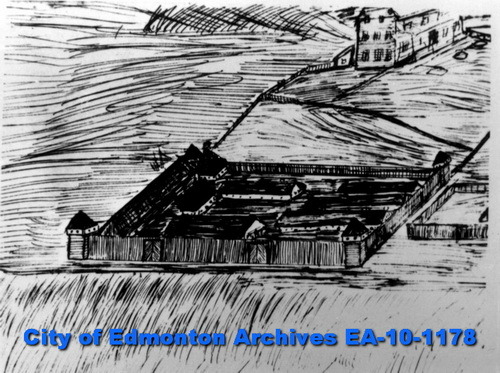
A sketch of the buildings at Fort Edmonton done by Dr. A. Whiteside, 1880, City of Edmonton Archives EA-10-1178.
Sitting in Yorath House next to the North Saskatchewan River doing online research on homestead records, and also reading newspaper accounts from the end of the nineteenth and early part of the twentieth centuries, I come face-to-face with racism. The accounts are written from the settler perspective. The City of Edmonton Archives on its website has posted the following statement:
The City of Edmonton Archives (CoE A) has developed this statement regarding the language used in archival descriptions to meaningfully integrate equity and reconciliation work into the City’s archival practice. The changes reflect the staff’s on-going efforts to acknowledge known instances of discrimination that appear in archival records.
Archivists have been working on identifying and contextualizing problematic content, language and imagery found in our collections since 2017. This was partly in response to the Truth and Reconciliation (TRC) Commission’s Calls to Action, specifically those aimed at cultural and heritage institutions. Further work is on-going in alignment with the City of Edmonton’s commitments to inclusion and respect for diversity and the work of various groups in the City and, specifically, of the Anti-Racism Committee of City Council, as well as the Association of Canadian Archivists’ Code of Ethics and Professional Conduct.
While the statement deals with the language in historic documents, there is a larger issue. The Government of Canada was intent on colonizing traditional Indigenous lands. The territories that became Canada initially attracted the attention of the British and French because of the bounty of fur-bearing animals. The fur of beavers, in particular, was used to create felt for hat making. Fur trading companies were the first major commercial enterprises (Hudson’s Bay Company and North-West Company) and were followed by others to harvest other natural resources including fish and stands of timber.
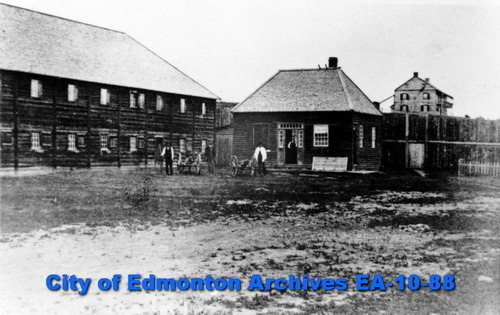
The interior of Fort Edmonton within the palisades showing the warehouse, Chief Factor’s House and Clerks’ quarters, 1894, City of Edmonton Archives EA-10-88.
With the signing of Treaty No. 6 on August 23, 1876 at Fort Carlton and on September 9, at Fort Pitt, the federal government was ready to unite the country “from sea to shining sea” through the building of a railway. The territory in question covered most of the central portions of what became, in 1905, the provinces of Saskatchewan and Alberta. The signatories were representatives of the Canadian Crown and the Cree, Chipewyan and Stoney nations.

Front and back of large medal presented to the Chiefs and councillors who signed treaties 1, 2, 3, 4, 5, 6 and 7. It shows a relief portrait of Queen Victoria and the representative of the Crown shaking hands with one of the Chiefs. Libraries and Archives Canada, Accession number: 1971-205 NPC.
Treaty 6 was mid-way in the 11 numbered treaties; Treaties 6, 7 and 8 cover most of Alberta. At the Fort Carlton meeting, on the part of First Nations, Chief Mistawasis (Big Child) and Chief Ahtahkakoop (Star Blanket) represented the Carlton Cree. On the part of the Crown, principal negotiators were Alexander Morris, Lieutenant Governor of the North-West Territories; James McKay, a Metis fur trader, and Minister of Agriculture for Manitoba; and W. J. Christie, Chief Factor of the Hudson’s Bay Company.
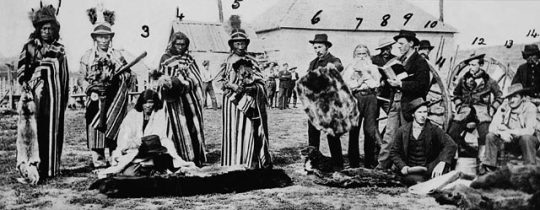
Chiefs at Fort Pitt trading with Hudson’s Bay Company representatives, autumn 1884, unknown photographer. L-R: Four Sky Thunder; Sky Bird (or King Bird), the third son of Mistahimaskwa (Big Bear); Moose (seated); Naposis; Mistahimaskwa; Angus McKay; Mr. Dufresne; Louis Goulet; Stanley Simpson; Constable G. W. Rowley (seated); Alex McDonald (in back); Corporal R. B. Sleigh; Mr. Edmund; and Henry Dufresne. There is a difference of opinion as to the names of the two corporals: some sources claim it is Corporal Sleigh and Billy Anderson, while others claim it is Patsy Carroll and H. A. Edmonds. Library and Archives Canada, Ernest Brown Fonds/e011303100-020_s1.
When Treaty negotiations began at Fort Pitt, on September 5, Cree Chief Mistahimaskwa (Big Bear) was away and therefore did not participate. Chief Weekaskookwasayin (Sweet Grass) led the discussions and appeared to accept that the terms of the Treaty would be beneficial; he was likely influenced by Chiefs Mistawasis and Ahtahkakoop. When Chief Mistahimaskwa returned, he was surprised that the other chiefs had not waited for him to return before signing. He had some important news to share: he had spoken to some of the signatories of previous Treaties and they had told him that they had been disappointed with the outcomes. Historian Hugh Dempsey has written that, if the Chief had been there, Treaty 6 may not have been signed. The entry in The Canadian Encyclopedia notes:
When Mistahimaskwa returned to Fort Pitt, he brought discouraging news with him from the Indigenous peoples on the prairies who had already signed Treaties 1 to 5: the treaties had not amounted to everything that the people had hoped. However, he was too late; the treaty had already been signed. Mistahimaskwa was frustrated and surprised that the other chiefs had not waited for him to return before concluding the negotiations. According to the notes of the commission’s secretary, M.G. Dickieson, Mistahimaskwa referred to the treaty as a dreaded “rope to be about my neck.” Mistahimaskwa was not referring to a literal hanging (which is what some government officials had believed), but to the loss of his and his people’s freedom, and Indigenous loss of control over land and resources. Dempsey argues that if Mistahimaskwa had been present at the negotiations, the treaty commissioners would have likely had a more difficult time acquiring Indigenous approval of Treaty 6. Mistahimaskwa was not the only chief who initially refused to sign the treaty. Chief Minahikosis (Little Pine) and other Cree leaders of the Saskatchewan District were also opposed to the terms, arguing that the treaty provided little protections for their people. Fearing starvation and unrest, many of the initially hesitant chiefs signed adhesions to the treaty in the years to come, including Minahikosis (who signed in July 1879) and Mistahimaskwa (who signed on 8 December 1882 at Fort Walsh).1
The “adhesions” involved the adding of signatories from other areas including Edmonton in 1877, Blackfoot Crossing in 1877, Sounding Lake in 1879, and Rocky Mountain House in 1944 and 1950. Treaty 6 encompasses 17 First Nations in central Alberta including the Dene Suliné, Cree, Nakota Sioux and Saulteaux peoples. The Edmonton adhesion was signed on August 21, 1877 on the land that would become the site of the Alberta Legislature. The site was a sacred gathering place for the Indigenous People of Alberta.
While the Treaties outline the rights, benefits and obligations to each other of the signing parties, there is no doubt that they were intended to enable a “land grab”: the Government of Canada wanted to open up the land for settlement. Indigenous People were to be confined to “reserves” and the remaining lands were to be made available. In 1869, Canada had purchased extensive parts of Rupert’s Land from the Hudson’s Bay Company but the Company, because of its historic role in the fur trade, retained extensive tracts of land. When the federal government gave the Canadian Pacific Railway a monopoly to build the railway through the prairies they were also given extensive lands not only for laying of tracks and building of stations but also for establishing town sites and farms.
As sovereign peoples, why would Indigenous People in what became Alberta and Saskatchewan want to sign Treaties? They came to the negotiations in good faith expecting that the Government of Canada would protect their lands from outsiders including white settlers, surveyors and the Métis. By the mid-nineteenth century, buffalo herds had declined, as had deer and other big game, and they faced starvation; in addition, various smallpox epidemics were decimating their population and that is why they negotiated the “medicine chest” provision in Treaty 6; it was literally to be housed with the Indian agent. In addition, the Government promised to assist the signatories in farming initiatives by providing various types of equipment.
With respect to the Metis or “mixed blood” peoples who were the result of marriages between fur traders and Indigenous women, the Government of Canada devised Métis scrip, which was a one-time payment whether in money or land that “extinguished” the individual’s land rights. Whether the recipients understood this is open to question. The certificate or warrant was issued by the Department of the Interior and printed by the Canadian Bank Note Company. Money scrip came in $20, $80, $160 and $240 increments. Land scrip came in allotments of 80, 160 and 240 acre (32, 65 and 97 hectare) increments. This allowed the Canadian government to acquire Métis rights to the land. As Robert Houle writes:
To the detriment of the Métis, who at the time did not fully comprehend the foreign system, traders like McDougall and Secord began to venture away from mercantilism. Through continued exploitation of the Crown system, McDougall and Secord were able to become “Edmonton’s First Millionaire Teachers”. The Scrip system allowed those with resources to purchase a certificate for face value or perhaps a marginal increase, then redeem the certificate on behalf, sometimes through fraud, of the original holder and re-sell for profit. Once a sale was undertaken, unbeknownst to Métis, their claims and rights would be extinguished in the eyes of the Crown.2
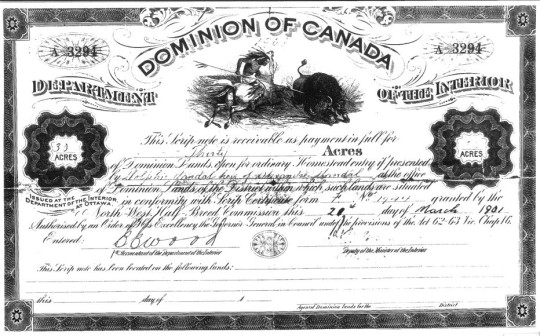
Métis Scrip for 30 acres issued March 20, 1901. Image Courtesy of the City of Edmonton archives MS-46 File 38.
In order for the land to be settled, it needed to be surveyed. This work had begun in 1871 after Manitoba became a province, and the North-West Territories was established as a result of the purchase of Rupert’s Land from the Hudson’s Bay Company. The Dominion Land Survey covered about 800,000 square kilometres and began with Manitoba and then continued West. In 1869, the first meridian was chosen at 97°27′28.4″ west longitude. The survey excluded First Nations’ reserves and federal parks. The Hudson’s Bay received Section 8 and most of Section 26.
The surveys were done in three stages: 1871-1879: southern Manitoba and a little of Saskatchewan; 1880: small areas of Saskatchewan; and 1881: the largest survey that includes what became Alberta. There was a sense of urgency about finishing the survey because the Government of Canada feared US encroachment into Canada. Over 27 million quarter sections were surveyed by 1883; maps and plans were given to the provinces. Townships were composed of 36 sections, and sections comprised 4 quarter sections or 16 subdivisions.
After Hudson’s Bay Company railway right of ways and school sections were carved out, the remainder became available for homesteads. The federal and provincial governments and municipalities advertised land availability for settlement. A homesteader had to pay a $10 fee to register a quarter-section and, within a term of three years, had to cultivate 30 acres (12 hectares) and build a house to gain title to the land. The bulk of prairie settlement occurred in the period 1885 to 1914.
With respect to the surveying of the land at Fort Edmonton, W. F. King did an initial survey for the Government of Canada in 1878. The formal survey was done in 1882 and adhered to the river lot pattern that the largely Métis population had established. This was based on the system used in Quebec. Because many of the Métis at Fort Edmonton and St. Albert had begun to settle the land and their small farms and landholdings adhered to the river lot system, this was grandfathered in.
The Hudson’s Bay Company had an extensive tract of land to the West of the downtown centred on Jasper Avenue (the Hudson’s Bay Reserve). The survey established 44 lots covering both sides of the North Saskatchewan River. These were East of the HBC reserve lands. By and large, these were Métis owned with the remainder purchased from the Company by current and former employees. The lots on the northern side of the River were even-numbered and the lots on the south side were odd-numbered. Among the former HBC employees were Malcom Groat, Colin Fraser, John Sinclair, Donald McLeod, James and William Rowland, Kenneth Macdonald, James Kirkness, John Fraser and James and George Gullion. Métis homesteaders included Joseph McDonald (River Lot 11), Laurent Garneau (River Lot 7), some of whom had also worked for the Company.3 These lots were by and large farmland until the communities of Edmonton and Strathcona began to expand quickly becoming towns and cities in the period from 1890 to 1914 when a worldwide economic recession and the First World War put an end to development.
Connor Thompson in “Edmonton’s River Lots: A Layer in Our History,” writes:
As the area’s fur trade was winding down, farming began to take on a greater importance in the lives of the people around Fort Edmonton. Many began staking claims to land in the Fort’s immediate vicinity, farming in a river lot fashion. A staple of Métis culture, this style of farming allowed for access to the river, wooded areas, cultivated land, and provided space for hay lands as well. While a rough (and unapproved) survey was undertaken by government surveyor W. F. King 1878, a more thorough government-approved survey in 1882 formalized the division of the land in terms of a river lot pattern, which is what the predominantly Métis population in the area at the time desired. The survey created 44 large lots across the banks of the North Saskatchewan, most of which stretched east of the Hudson’s Bay Company reserve lands. In many ways, the early history of these river lots is a history of the Métis and their kinship networks – marriage between the area’s families was common, as were friendship and support systems.
Other south side families faced struggles relating to their Indigenous identities, especially with the pressures of Métis scrip and the 1885 rebellion – Métis scrip was a one-time payment of either money or land that, in the eyes of the Canadian government, extinguished the person’s Indigenous land rights. Scrip was notorious for its convoluted process and unethical nature. Many families on these south-side river lot farms, including the family of William Meaver on River Lot 15 (bounded by present-day 99th St. to 101 St.), Charles Gauthier and his son on River Lot 17 south (99th St. and Mill Creek Ravine), George Donald and Betsy Brass of River Lot 21 (91st to 95th St., in the present-day Bonnie Doon neighborhood), took scrip. Some of the families that were members of the Papaschase band either took scrip (as Brass herself, who was a woman of mixed Cree/Saulteaux ancestry did), or joined the Enoch band, as William Ward’s family (of River Lot 13) did. As settlement increased, many Métis families of this period would leave to places such as St. Paul des Métis, St. Albert, Tofield, and Cooking Lake.
As the largely British towns of Edmonton and Strathcona grew, the Indigenous origins of the land were erased and the rights of Indigenous Peoples violated.
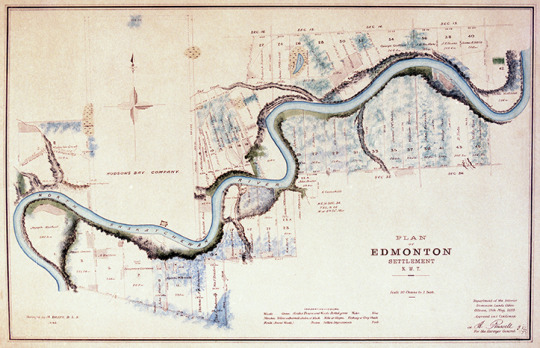
Edmonton Settlement showing the river lots, ca. 1882. City of Edmonton Archives EAM-85.
Interpreting History
In August 1951, my Mother Estera, older sister Rosa and my brother Giuseppe and I joined our Father, Raffaele Albi in Edmonton. He had left Italy in 1949 and made his way to Edmonton and begun work for an Italian-owned company, New West Construction. The company was helping to finish the Imperial Oil Refinery in Strathcona. In 1953, my parents purchased an old house on 127 Street and 109A Avenue in the Westmount area. That September, we went to school at St. Andrew’s Elementary School across from the Charles Camsell Hospital. That is when I encountered racism personally: as a dark and thin southern-Italian kid, I became the target of “half-breed” jokes. I knew who these people were because daily I watched the dark-skinned children looking at me through the chain-link fence that surrounded the Hospital. They looked sad and I felt that they were jealous watching us play our care-free games in the school yard. There were some Métis children in my school and I quickly made friends with members of the L’Hirondelle, Mercier and Majeau families not realizing that for some of my school mates this was not done.
It came as a surprise to me that Italians were considered a “visible minority” and therefore the butt of jokes, many about the Mafia, DPs, Wops or other pejorative terms. I was thus sensitized to “being different.” When I was in junior high, I decided that I wanted to be a journalist and, in 1962, became a student at the University of Alberta with an English major and French minor. I volunteered with the student newspaper, The Gateway, and the summer of 1964 was a student intern at The Edmonton Journal.
Two traumatic experiences occurred that summer that helped to shape my thinking and influenced my life and career. A friendly journalist told me that there was a bet on at the Greenbriar Lounge, where the largely male staff went to drink, as to who would get me into bed (nobody did!). The other occurred when on weekend duty I was assigned to cover a story on a northern reserve. Weekend duty was assigned to younger staff and the carrot was that you got to do a photo essay for the Sunday newspaper. A young photographer and I drove up to the reserve and I remember arriving in a tiny, tiny community (it wasn’t large enough to be described as a town) and going to what looked like the community hall. Dave and I entered an extremely smoky room where all the men were talking animatedly. When we introduced ourselves, they were extremely kind and I began the interviews. I discovered that they were discussing Treaty rights and that the Government of Canada was not honouring these. I was captivated. On our return to the Journal offices late that evening (Saturday), I wrote the article telling their story. I was delighted with the two-page spread that included David’s photographs of the Chiefs and Elders. The following Thursday at the weekly Editorial meeting, Editor Andrew Snaddon tore strips off me for having “lost my objectivity” and only told the “Indian” side of the story. From that day forward, I knew that I wanted to continue to tell those stories.
The first opportunity came in January 1987 when I started work as the executive director of the Alberta Museums Association. I took a call in the first week from someone wanting to know what “ICOM Resolution 11” was. I didn’t know so I called the Canadian Museums Association and learned that the International Council of Museums at its General Assembly in 1986 in Buenos Aires, Argentina had passed a resolution that was to guide museums in dealing with living Indigenous communities. It stated:
Resolution No. 11: Participation of Ethnic Groups in Museum Activities
Whereas there are increasing concerns on the part of ethnic groups regarding the ways in which they and their cultures are portrayed in museum exhibitions and programmes, The 15th General Assembly of ICOM, meeting in Buenos Aires, Argentina, on 4 November 1986, Recommends that: 1. Museums which are engaged in activities relating to living ethnic groups, should, whenever possible, consult with the appropriate members of those groups, and 2. Such museums should avoid using ethnic materials in any way which might be detrimental to the group that produced them; their usage should be in keeping with the spirit of the ICOM Code of Professional Ethics, with particular reference to paragraphs 2.8 and 6.7.
The resolution enshrined consultation on all Indigenous exhibits and programs that has become a practice with Canadian museums. When I called back and gave the mystery caller this information, I asked who they represented and learned that it was the Lubicon Cree. This northern Alberta First Nation had been left out of Treaty 8 negotiations. They had filed a claim with the federal government as early as 1933, for their own reserve but nothing had been done to resolve the matter. Pressures on their traditional way of life resulting from the number of oil companies drilling on the contested territory had accelerated their need for a settlement. Under a new, young Chief, Bernard Ominayak, the cause received renewed impetus and he sought the help of professionals.
American human rights activist Fred Lennarson became his chief advisor in 1979. His consulting company, Mirmir Corporation, had already done work for the Indian Association of Alberta (under Harold Cardinal). Ominayak and Lennarson aimed to get a $1 billion settlement from the federal government and, to do this, organized an aggressive letter writing and media campaign. By 1983, they were mailing information about the land claim dispute to over 600 organizations and individuals around the world and had been successful in obtaining the support of the World Council of Churches and the European Parliament. Knowing that they would need the support of Indigenous organizations, they had extensive meetings and, among the first to come on board were the Assembly of First Nations, the Indian Association of Alberta, the Métis Association of Alberta and the Grand Council of Quebec Cree.
Subsequently, when the Glenbow Museum launched its exhibit, curated by Julia Harrison, titled “The Spirits Sings,” as part of the Calgary Winter Olympics in 1988, there were protestors there indicating the museum had violated ICOM Resolution 11 and also attacking the display of “False Face” sacred masks that were on display. In fact, Harrison had had an Indigenous advisory committee and the masks had previously been on display in Ontario museums as well as in the Canadian Embassy in London, England, without objections. This event galvanized museum personnel to undertake some serious reflection on the way in which they represented Indigenous history and artifacts.
The Canadian Museums Association with the Assembly of First Nations undertook the Task Force on Museums and First Peoples and I was delighted to take part in this work which was led on the museum side by Morris Flewwelling, the CMA President at the time. With the support of the Board of the Alberta Museums Association, we created three symposia held in 1988, 1989 and 1990 to address the relationship between museums and First Peoples, repatriation of ceremonial and sacred objects, and the topic “Re-inventing the Museum in Native Terms.” For this last, I invited representatives from the Ak-Chin Eco-Museum in Arizona. The community, which was established in 1912 as a reservation, was plagued by poverty and scarcity of resources until it declared itself an “ecomuseum” and focused on preservation of its language and culture to promote economic development.
As a result of information gathered through our symposia and meetings with representatives from various Indigenous communities (both within and outside of Alberta), I was delighted to provide advice to a number of Indigenous museum projects. I could not have done this work without the help of some prominent individuals, who championed Indigenous history and were chiefs, elders and ceremonialists. The most important were Russell Wright and wife Julia; Leo Pretty Young Man Senior and wife Alma; and Reg Crowshoe and wife Rose. They participated willingly in the Alberta Museums Association Indigenous symposia and in other planning and advisory work.
Russell struggled to maintain a museum in the old Residential School at Blackfoot Crossing on the Bow River East of Calgary. In the 1970s, he had helped to develop a Blackfoot studies program for the Old Sun College on the reserve. He was troubled by the high rate of student suicides on the reserve and firmly believed that it was only through the renewal of the Blackfoot culture and language that this trend could be halted. I did my best in advising him as to how to go about fundraising for a new museum, which had been his dream since the 1977 centenary celebrations of the signing of Treaty 7 (Prince Charles attended the ceremonies). With Leo Pretty Young Man Senior and wife Alma as well as other Elders and their wives, he envisioned an appropriate building that would house cultural artifacts and function as an education centre.
The Blackfoot Crossing Historical Park is a legacy to their vision. In 1989, six square kilometres of land were set aside but funding would not become available until 2003 to initiate construction. Neither Russell nor Leo lived to see the museum, which was completed in 2007. The iconic teepee-like structure was designed by architect Ron Goodfellow. The Buffalo Nations group, headed by Leo, took over the old Luxton Museum in Banff and I was delighted to attend planning meetings to assist them to obtain grants to develop new exhibits, care for collections and undertake necessary restoration work to the building. The Buffalo Nations Luxton Museum became a popular attraction in Banff.

The vista from the rear windows of the Blackfoot Crossing Interpretive Centre, which is a National Historic Site of Canada located near Cluny, Alberta. The area in southern Alberta is significant as both a geographic and cultural centre of Blackfoot territory and includes the grassy flood plain of the Bow River Valley. It was the location where Treaty No. 7 was signed in 1877 by representatives of the the Siksika (Blackfoot), Pekuni (Peigan), Kainai (Blood), Nakoda (Stoney) and Tsuu T'ina (Sarcee) First Nations. They surrendered their rights to 50,000 square miles of territory. Numerous archaeological resources and historical features are located there including the grave of Chief Isapo-Muxika (Crowfoot). Photographer: Adriana A. Davies.
Another of my Indigenous mentors was Reg Crowshoe, a former chief of the Piikani Blackfoot First Nation, who had worked as an RCMP officer. He assisted the Historic Sites Service on various projects and generously shared his traditional knowledge with students at the universities of Lethbridge and Calgary. He founded the Old Man River Cultural Society and followed in the footsteps of his father, Joe Crow Shoe Senior. Joe was an Elder and Bundle Keeper and ran Sun Dances; he renewed the Brave Dog and Chickadee Societies. Father and son collaborated with Historic Sites Service, Government of Alberta, and were instrumental in the building of Head-Smashed-In Buffalo Jump Interpretive Centre near Fort Macleod, which showcases and interprets Blackfoot culture. It opened in 1987 and is run by Alberta Culture. It is a Canadian national historic site and UNESCO World Heritage Site.
Gerald Conaty, Julia Harrison’s successor at Glenbow as Curator of Ethnology, was an invaluable resource and took me on a number of field trips to Treaty Seven areas to meet with Elders and ceremonialists. Beginning in 1990, he helped the Glenbow to develop and implement repatriation policies with respect to sacred objects. The initial work was done by Hugh Dempsey, long-time Glenbow curator and sometime Acting Director, who had extensive relationships in the Indigenous community going back to his involvement with the Indian Association of Alberta. He married Pauline Gladstone, the daughter of James Gladstone, the first status Indian appointed to the Canadian Senate. In mid-1990, Dempsey with Board approval loaned a medicine bundle to Dan Weasel Moccasin for a ceremony thereby setting a precedent. The bundle was returned.
Towards the end of my tenure as Executive Director of the Alberta Museums Association around 1998-1999, I was involved in an interesting project titled “Lost Identities” put together by Historic Sites Service Museums Advisor Eric Waterton; Provincial Archives of Alberta Archivist, Marlena Wyman; Pat Myers, historian with the Provincial Museum of Alberta; and Shirley Bruised Head, the Education Officer at the Head-Smashed-In Buffalo Jump Interpretive Centre. We wanted to develop a photographic exhibit for the Centre and Marlena scanned their collection for a cross-section of photos representing Treaty 7 people. When the committee reviewed them, we noticed that archival photographs frequently had the label “unknown Indian.” We decided to focus on those photographs for the exhibit and selected about 30 photographs that were enlarged and framed. They were hung in an exhibit room at the Interpretive Centre and next to each was a copy of the photograph with blank outlines of the people. Visitors to the exhibit were encouraged to identify anyone they knew.
I remember well the exhibit launch organized by Shirley. There was a feast for the Elders and after the blessings were finished, the exhibit was introduced and the participants began to walk around looking at each photograph carefully. For some time, there was absolute silence in the room followed by a kind of buzzing noise as they began to talk to each other and point at people they knew.
Shirley was an extraordinary woman (Sacred Hill Woman "Naatoyiitomakii"), who died too soon in 2012. She was a member of the Piikani Nation and she and her twin sister Barbara were born on the reserve on February 19, 1951 to Irene and Joe Scott. Her parents ranched. After their early death, the children were separated and she grew up in her Uncle’s home in Siksika and then moved to Edmonton to attend St. Joseph’s High School. She married Norbert Bruised Head and supported his rodeo career and worked for Native Counseling Services in Lethbridge. She obtained a BA degree from the University of Lethbridge and, later, a Master’s in Education. She was a ceremonialist and was a pipe owner; she assisted in the beaver bundle ceremony.
A committee of former presidents of the Alberta Museums Association met for several years to discuss how to make the Association more financially independent and how to promote museums more effectively. The result of this was the creation of the Heritage Community Foundation in summer 1999 with the mandate “to link people with heritage through discovery and learning.” At that time, I was a member of the Canadian Heritage Information Network (CHIN) advisory committee and involved in a “Museums and the Web” study. I quickly became convinced that the World Wide Web offered enormous opportunities for promoting heritage. The Foundation obtained funding to create our first website – a kind of overview of Alberta’s heritage and museums – and this gave us our direction.
I pitched to the Board that the primary focus of the Foundation should become the development of web content drawing on museum and archival collections and, furthermore, that we should create the “Alberta Online Encyclopedia.” They wholeheartedly endorsed this and www.albertasource.ca was born. Luck and, I guess, timing was on our side. In March 2001, CHIN launched the Virtual Museum of Canada, which had a grants program, and I knew which project to bring forward. The Spirit of the Peace Museum Network had developed a travelling exhibit titled “The Making of Treaty 8 in Canada’s Northwest.” It was rich in artifacts, documents and records. I approached Fran Moore, the Chair of the network, and asked whether they would partner with us and the answer back was an unequivocal, “Yes!” It was all systems go. I developed the grant application, which was jointly submitted, and we obtained funding to hire some project staff and a firm of web developers. In the end, content and images for the bilingual website were contributed by not only the Museums of the Peace but also, the Glenbow, Provincial Museum of Alberta, Treaty 8 First Nations and the Lobstick Journal. I remember going up North to test the site with Elders and seeing the excitement on their faces when they began to identify relatives in the archival photos. The website was launched in 2002 and CHIN was thrilled with it.
In 2004, we designed a project to celebrate Alberta’s centenary: expansion of the websites in order to cover Alberta’s social, natural, cultural, scientific and technological heritage. Albertasource.ca, the Alberta Online Encyclopedia, received a $1 million Centennial Legacy grant. On September 29, 2005, the Foundation launched the Encyclopedia – the Province’s intellectual legacy project – at the Edmonton Space and Science Centre to a supportive crowd including children from neighbourhood schools.
After development of the Treaty 8 website, we moved all technical development in-house because we found that we could better control quality as well as guaranteeing that websites were completed on time. This was crucial because in some instances the majority of funding was received on project completion. Of our first four interns, two stayed on with us for a number of years and became permanent staff. Dulcie Meatheringham, a young Métis woman from Northern Alberta, became our first webmaster. Over the 10-year life of the Foundation, we had over 450 interns, most for three-month internships.
There are certain groupings of websites that the Trustees and I take particular pride in; among them are the over 30 websites that are either wholly or partly devoted to Indigenous content. All involved partnerships with Treaty organizations and the Métis Nation of Alberta. These include sites on individual treaties as well as Alberta’s Metis Heritage, People of the Boreal Forest and Elders’ Voices. The last included content from the “Ten Grandmothers Project” undertaken by Linda Many Guns of the Nii Touii Knowledge and Learning Centre; the Centenarians, a nine-minute video production celebrating Indigenous women resulting from a partnership between Aboriginal Affairs and Northern Development, the Institute for the Advancement of Aboriginal Women and EnCana Energy. We also undertook some oral histories of Métis veterans. Thirteen Edukits draw on the content of the various websites and provide teacher and student resources directly related to the K-12 curriculum. They are: Alex Decoteau; Origin and Settlement; First Nations Contributions; Culture and Meaning; Language and Culture; Spirituality and Creation; Health and Wellness; Leadership; Physical Education, Sports and Recreation; Math: Elementary; Science; and Carving Faces: People of the Boreal Forest.
I am proud of the fact that we created three Indigenous internship programs in partnership with the Northern Alberta Institute of Technology that trained young people in web design. We obtained some funding from Western Economic Diversification in support of the project. We had not only interns who specialized in web design but also graduates in history who wrote site content. They worked on both Indigenous and non-Indigenous websites. Some have made careers in this area. On June 30, 2009, the Heritage Community Foundation gifted the Alberta Online Encyclopedia to the University of Alberta so that it could make available the websites in perpetuity.
What people in the museum and heritage field accomplished in partnership with Indigenous Peoples and institutions from 1987 to the present is only a beginning. As we move into the era of the “decolonizing of museums,” a whole new generation of Shirley Bruised Heads, Linda Many Guns and others are needed. It’s good to see these new voices, talents and abilities emerging and tackling recommendations from the Truth and Reconciliation Commission. I was privileged to be able to attend the last day of the Commission hearings held in Edmonton from March 27-30, 2014 at the Shaw Conference Centre. I eagerly awaited the release of the report in June 2015 and have tracked how heritage and arts organizations have begun to implement its recommendations.
The last physical event that I attended before Covid was the Edmonton Heritage Council’s Symposium titled “Reconciliation and Resurgence: Heritage Practice in Post-TRC Edmonton.” Their website notes:
On March 3 and 4, 2020, 150 people came together at La Cité Francophone to discuss Reconciliation and Resurgence in post Truth and Reconciliation Commission Edmonton. Members of the Indigenous community, Edmonton’s heritage sector, academics, not-for-profit workers, students, public sector workers, and members of the public, came together to learn how each of us can contribute to reconciliation work in the heritage community. Those in attendance were encouraged to consider and examine the ways in which Indigenous peoples and heritage have been and continue to be excluded or marginalized within heritage institutions and narratives. We asked attendees to think critically about their own roles in this pattern of erasure, and to consider a way forward where Indigenous voices are lifted up, where Indigenous heritage is told by Indigenous people, and how historical erasure and marginalization has contributed to the current realities of systemic racism.
The Edmonton Heritage Council was advised by Elders and community members from First Nations, Métis, and Inuit communities throughout the planning process. Each day of the symposium began in ceremony with smudging and a prayer.4
From the 15 - 18 of March, 2021, I attended a virtual symposium organized by the International Committee for Museology of the International Council of Museums, which is part of UNESCO. I have been a member for over 30 years and served on the ICOM Canada Board. The conference was to take place in Montreal but Covid turned it to an online encounter. The topic was “Decolonizing Museology: Museums, Mixing and Myths of Origin.” The focus was as follows:
The purpose of the ICOFOM Annual Meeting is to create an international forum for a high level discussion on a museological topic. Usually, the topic is different each year, but sometimes it is analyzed over a three year period.
Approaches to museology vary widely around the world, for example, using museums to make statements about nationalism is given priority in some countries. In others, conservation and the exhibition of highly aestheticized, non-controversial artefacts, are regarded as the primary roles for museums. By contrast, in other nations, the development of “histories from below” or the salvaging of the histories of the lives of people who were regarded as having no value, is now a primary museological focus. The wide international variety of museologies means that the annual meeting has fundamental importance for the expression and recording of these differences.
I am looking forward to seeing the next era of history writing and interpretation.
The Dome
Standing on the Dome, Dawson City,
You can see the fingers of river stretching towards the Bering Strait.
Rotating through 360 degrees,
The various landscapes open up to you.
The place is magical –
Both in its natural and human elements.
The light, in this Land of the Midnight Sun,
Is like no other.
It brings out the artist in me.
I want to paint word pictures—
Of rocks, trees, sky and water,
A haze smudging the distant mountains into the cloud cover.
Time present and time past merge.
Geological time has shaped rock formations;
Glaciation normally softens these, but not in this valley;
And vegetation adds the finishing touches.
Up here, the town site is miniscule—
The works of man diminished by the works of nature.
The reverse of what is seen at the valley floor,
Where churned-up gravels dominate.
There, the striations of gold-dredging,
Form giant worm leavings—
The only industrial operation that almost looks natural—
The regularity and symmetry of gravel ridges resembling a moraine.
Dredge no. 4 now sits tethered.
Its work of creating new landforms ended.
Its appetite for muskeg stilled by economic forces,
The devaluing of the sovereign metal.
And what of those changed lives?
The preserved buildings are a memorial to them.
Window displays tell of events,
And objects are tangible evidence.
You can identify buildings and streets,
Forming the background of archival photos.
But, what you don’t get are the raw emotions—
The greed, flimflam, pain and loss.
When it all went bust,
Those gold gypsies walked away,
Leaving their possessions behind, like empty cocoons—
The residue of a transitory, disposable society.
We now want to put those lives on show,
In restored and recreated buildings,
For the entertainment of bus-tour travellers.
How can we do it and pay homage to their humanity?
In the window in the madam’s house,
I see photos—a woman in a fashionable, fifties swing coat with a dog,
Also a family portrait with an Oriental man and little boy.
Was it greed that brought this genteel Parisienne to the Yukon?
The priests and religious are also there.
Ministering to their flocks brought hardship and even death.
Did they feel it was worth it, in the end,
When facing their Maker?
The substantial buildings survive,
Set down for a future territorial capital,
Their neoclassical tin facades,
Bravely face river and forest.
Those gold hustlers must have had other qualities to counter the greed.
Some must have come to stay—
To put down roots,
And leave a legacy for their children.
What about the Native People—
Skookum Jim and Tagish Charlie?
Cast as bit players in this colonial saga,
Their impassive countenances don’t say much.
We need the Han Centre to place the Gold Follies in a larger context.
Indigenous time and values—
Centuries in the making—
Providing a silent commentary on white mayfly lives.
Did they know that it would be heritage tourism —
The “gold rush” of the early 20th century—
That would provide the window on their lives,
The measure of their success whether they struck it rich or not.
The aged prospector in the CBC documentary,
Repeats the eternal round of digging into the earth,
Like an Ancient Mariner marooned in mid-century,
A generation away from when the action left Dawson.
Museums have serious powers.
Unearthing the past has its responsibilities.
Each day, we make and break reputations—
Validate one person’s struggle, while ignoring another’s.
We have become dream merchants.
A rootless civilization finally coming to its senses,
Needing the bone, twigs, cloth and feathers
Of heritage “shamans” to reconstruct the world.
Is a code of professional ethics enough?
Or do we acknowledge our powers—
To create the symbols and icons for the next generation,
And turn job into vocation?
Whitehorse, June 3, 1998, Canadian Museums Association conference
________________________________________________
1 Michelle Filice, “Treaty 6,” The Canadian Encyclopedia Online, URL: https://www.thecanadianencyclopedia.ca/en/article/treaty-6, retrieved January 15, 2022. See also Harold Cardinal and Walter Hildebrand, Treaty Elders of Saskatchewan: Our Dream is that Our Peoples Will One Day Be Clearly Recognized As Nations (2000).
2 Robert Henry Houle, “Richard Secord and Métis Scrip Speculation,” June 28, 2016, Edmonton Heritage Council, Edmonton City as Museum Project, URL: https://citymuseumedmonton.ca/2016/06/28/richard-henry-secord-and-metis-scrip-speculation/
3 See Connor Thompson, “Edmonton’s River Lots: A Layer in Our History,” September 9, 2020, URL: https://www.google.com/search?q=Edmonton%27s+River+Lots&ei=QBraYfTfC5mU0PEPuq-0oAk&ved=0ahUKEwj0_7fYo6P1AhUZCjQIHboXDZQQ4dUDCA4&oq=Edmonton%27s+River+Lots&gs_lcp=Cgdnd3Mtd2l6EAxKBAhBGABKBAhGGABQAFgAYABoAHAAeACAAQCIAQCSAQCYAQA&sclient=gws-wiz
4 See “Reconciliation and Resurgence: A Year Later,” Edmonton Heritage Council, URL: https://edmontonheritage.ca/blog/2021/03/04/reconciliation-and-resurgence-one-year-later/, retrieved January 18, 2022.
8 notes
·
View notes
Text
Title in Progress...
Title in Progress...
https://ift.tt/1JNTh7z
by Luna_Cadenza
Little Harry Potter wakes up to find himself in Gringotts Bank, surrounded by Goblins. The six-year-old then learns that his life is a lie. Everything he has even been told has been a lie. He is not who or what he thought he was nor who his parents were/are. He actually has a family, parents and siblings!! And wait... he's a creature? What does that mean? Also...
"I have four dad's and one mum?"....... "How does that work?"
Follow Harry as he embarks on a journey to reunite his parents and siblings. Can they stop Dumbledore from ruining all that his family has worked for? Can they defeat the so called "Lord of the Light"?
Hang on a second, what prophecy?
Words: 1178, Chapters: 1/?, Language: English
Fandoms: Harry Potter - J. K. Rowling
Rating: Teen And Up Audiences
Warnings: Graphic Depictions Of Violence, Major Character Death
Categories: F/M, M/M, Multi
Characters: Harry Potter, Tom Riddle | Voldemort, Bellatrix Black Lestrange, Rodolphus Lestrange, Rabastan Lestrange, Fenrir Greyback, Severus Snape, Barty Crouch Jr., Draco Malfoy, Pansy Parkinson, Theodore Nott, Original Characters
Relationships: Tom Riddle | Voldemort/Severus Snape, Bellatrix Black Lestrange/Tom Riddle, Fenrir Greyback/Tom Riddle, Bellatrix Black Lestrange/Rodolphus Lestrange/Tom Riddle, Tom Riddle/Bellatrix Black Lestrange/Rodolphus Lestrange/Fenrir Greyback/Severus Snape, Theodore Nott/Harry Potter, Hermione Granger/Draco Malfoy, Neville Longbottom/Pansy Parkinson, Lucius Malfoy/Narcissa Black Malfoy
Additional Tags: Multiple Relationships, eventual nottpott, eventual Dramione, Eventual Neville Pansy, They're just babies, Sane Tom Riddle, Creature Tom Riddle, Creature Bellatrix Black Lestrange, Creature Severus Snape, Creature Harry Potter, Creature Hermione Granger, Creature Neville Longbottom, Harry Hermione Neville are triplets, Magical Rituals, Evil Albus Dumbledore, Manipulative Albus Dumbledore, Tom Riddle is Not Voldemort, Parental Tom Riddle, Parental Severus Snape, Parental Bellatrix Black Lestrange, Sane Bellatrix Black Lestrange, James Potter is Not Harry Potter's Parent, Lily Evans Potter is Not Harry Potter's Parent, Good James Potter, Good Lily Potter, they were tricked, Severitus | Severus Snape is Harry Potter's Parent, Minor Character Death, Good Malfoy Family, Theo's dad is not an ass, Lucius Malfoy - Freeform, Narcissa Black Malfoy - Freeform, Good Parent Lucius Malfoy, Good Parent Narcissa Black Malfoy, Good Parent Tom Riddle, Good Parent Fenrir Greyback, Good Parents all around, Molly Weasley Bashing, Bad Molly Weasley, Ron Weasley Bashing, Ginny Weasley Bashing, Good Arthur Weasley, Good Weasley Twins
via AO3 works tagged 'Hermione Granger/Draco Malfoy' https://ift.tt/XZx3q9S
March 31, 2024 at 03:15AM
3 notes
·
View notes
Text
Party at J's Gargoyle
by NerdyLibrarian
Oracle notices Jason behaving in a worrying manner after he discovers the body of a missing child. Fortunately, the family of traumatized vigilantes has a system for handling nights like this. Cue the Party Protocol.
Words: 1178, Chapters: 1/1, Language: English
Fandoms: Batman - All Media Types, Batman: Under the Red Hood (2010)
Rating: General Audiences
Warnings: Creator Chose Not To Use Archive Warnings
Categories: Gen
Characters: Jason Todd, Barbara Gordon, Dick Grayson, Tim Drake, Duke Thomas, Stephanie Brown, Damian Wayne, Cassandra Cain, Bruce Wayne, Alfred Pennyworth
Relationships: Barbara Gordon & Jason Todd, Dick Grayson & Jason Todd, Tim Drake & Jason Todd, Jason Todd & Damian Wayne, Stephanie Brown & Jason Todd, Cassandra Cain & Jason Todd, Duke Thomas & Jason Todd, Alfred Pennyworth & Jason Todd, Jason Todd & Bruce Wayne, Batfamily Members & Jason Todd
Additional Tags: Depressed Jason Todd, Suicidal Thoughts, Past Character Death, that's jason, Referenced death of unnamed Alley child, Jason Todd Needs A Hug, BAMF Barbara Gordon, Good Sibling Dick Grayson, Good Sibling Tim Drake, Good Sibling Damian Wayne, Good Sibling Cassandra Cain, Good Sibling Stephanie Brown, Good Sibling Duke Thomas, Good Grandparent Alfred Pennyworth, Bruce Wayne is a Good Parent, Jason Todd Has PTSD, Suicidal Jason Todd
source https://archiveofourown.org/works/45840550
0 notes
Photo
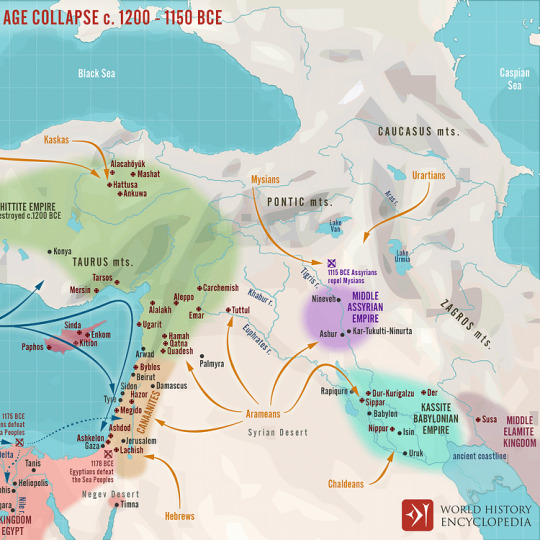
Peuples de la mer
Les Peuples de la mer étaient une confédération d'aventuriers des mers qui harcelèrent les villes côtières de la région méditerranéenne entre 1276 et 1178 avant notre ère, en concentrant leurs efforts sur l'Égypte. Ils sont considérés comme l'une des principales causes de l'effondrement de l'âge du bronze (c. 1250-c.1150 av. J.-C.) et étaient autrefois considérés comme la cause principale.
Lire la suite...
0 notes
Text
When you get hurt
Hataraku saibou black (WBCS and RBCS) x Female/Male! Reader
-------------------------------------------------
U-1196:

-Oh dear, Oh dear, Gorgeous
-She becomes a ✨mama✨
-U-1196 will make sure you are feeling better and if you need something she's there for you
-"Babe, you need something?"
-when It's bed time she would read a book for you
-Cuddles, cuddles and cuddles
-Kisses, kisses and kisses
-she would stop doing what she was doing only to stay with you
-"CAPTAIN?! WHERE ARE YOU?!"
-"Oh I'm with Y/n"
-"COME BACK HERE WE NEED YOU!"
-"Nah. You can do it for yourself"
-"CAPTA---"
-*Closes call* "Anyway I was saying---"
U-8787:

- ✨P A N I C✨
-She doesn't know what to do
-She asks U-1196 for help---
-"SENPAI WHAT SHOULD I DO?!"
-"Calm down U-8787---"
-"AHHHHHHHHH"
-U-8787 would stay by your side and refuses to work only to stay with you
-would do anything for you
-always blames herself to not be able to protect you but you always say it's not her fault
-"IT'S ALL MY FAULT---"
-"Babe, actually it's not---"
-"IT IS!"
U-1212:
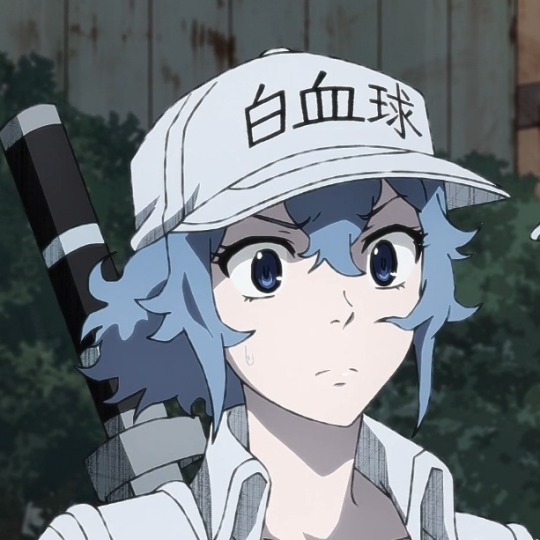
-Tries to stay positive but fails
-U-1212 would carry you to the hospital since she doesn't know what to do
-"HELP MY F*CKING GIRLFRIEND/BOYFRIEND RIGHT NOW---"
-U-1212 would tell you how the day went and how many germs she killed
-Sleeps next to you, snoring...a lot
-If you complain about the pain U-1212 will try to help you and not having a mental breakdown
-makes sure you won't hurt yourself again
J-1178:

-she's like U-1196
-She's becomes a ✨little mama✨
-Would take care of your wounds and blame you for not paying attention
-"You MUST pay attention next time!"
-"Hehe! Sorry!"
-"MPH!"
-Would give you cuddles everytime you want
-makes hot chocolate for the both of you
-while sleeping she would hug you close to her beacuse you mean the world to the little white blood cell
AA2153:

-He tries to not blame himself like U-8787 but he fails
-The red blood cell would carry you in a safe place and try to help you in any way
-Asks to AC1677 for help
-would take you to his apartment and let you rest on his bed
-checks every. Single. Second if you are feeling okay
-"Babe are you sure you're okay?"
-"Yes I'm fine, now come here I want cuddles!"
-"S-SURE---"
-Cuddles!
AC1677:

-Ah geez
-he doesn't know what to do
-asks for help to AA2153
-would stop delivering oxygen only to stay by your side
-"Sweetie you need to work--"
-"Hell no! Look at you! I won't leave your side until you won't feel better"
-this guy always makes you laugh
-fells asleep next to you for making you company
-would tell you how was his day and of course he would tell you some jokes
NC8429:

- ✨P A N I C✨ OVER 9000!!!
-Oh god, oh no---
-he is only a little chubby cheeks baby he doesn't know what to do in these situations
-"OMG WHAT SHOULD I DO?! SHOULD I CALL SENPAI? MISS WHITE BLOOD CELL?! I DON'T KNOW!"
-In the end he asks for help to everyone
-cries because he thought for a moment that you would have left him alone
-you comfort him
-"Hey cutie it's okay, I'm here!"
-"I was so scared when you got hurt!"
-makes you food all the time
-sometimes he messed up but you don't mind
-Cuddles everyday
43 notes
·
View notes
Text
не відчуваю зими
read it on the AO3 at https://ift.tt/AkutFQ1
by celebrimban
Я ж не просто так кличу тебе "полум'яна", моя люба? - Майрен всміхнулась.
І Мелькор справді не відчувала зими.
Words: 1178, Chapters: 1/1, Language: Українська
Series: Part 1 of фемгрудень 2022
Fandoms: The Silmarillion and other histories of Middle-Earth - J. R. R. Tolkien
Rating: Teen And Up Audiences
Warnings: Creator Chose Not To Use Archive Warnings
Categories: F/F
Characters: Morgoth Bauglir | Melkor, Sauron | Mairon
Relationships: Morgoth Bauglir | Melkor/Sauron | Mairon
Additional Tags: Hurt/Comfort, Winter, Trauma, Chronic Pain, Angst and Hurt/Comfort, Flashbacks, Alternate Universe - Gender Changes, Lesbian Character, Married Couple, Hugs
read it on the AO3 at https://ift.tt/AkutFQ1
0 notes
Text

I posted 1,243 times in 2021
65 posts created (5%)
1178 posts reblogged (95%)
For every post I created, I reblogged 18.1 posts.
I added 1,598 tags in 2021
#there is only one queue! - 661 posts
#soul eater - 183 posts
#friday night funkin - 155 posts
#danny phantom - 135 posts
#omori - 131 posts
#pokemon - 71 posts
#persona - 69 posts
#danny hon au - 68 posts
#blue exorcist - 65 posts
#king talks - 60 posts
Longest Tag: 139 characters
#they didn't feel comfortable putting it alongside of their other ones because they didn't want people to think they supported j/k/rs action
My Top Posts in 2021
#5
Danny: calls Vlad a fruit loop
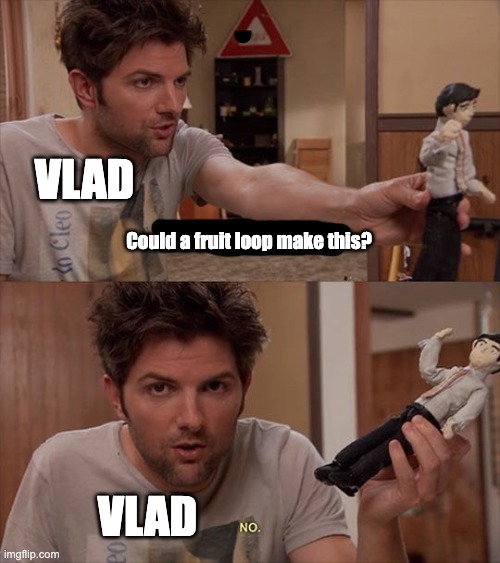
51 notes • Posted 2021-10-29 22:03:27 GMT
#4
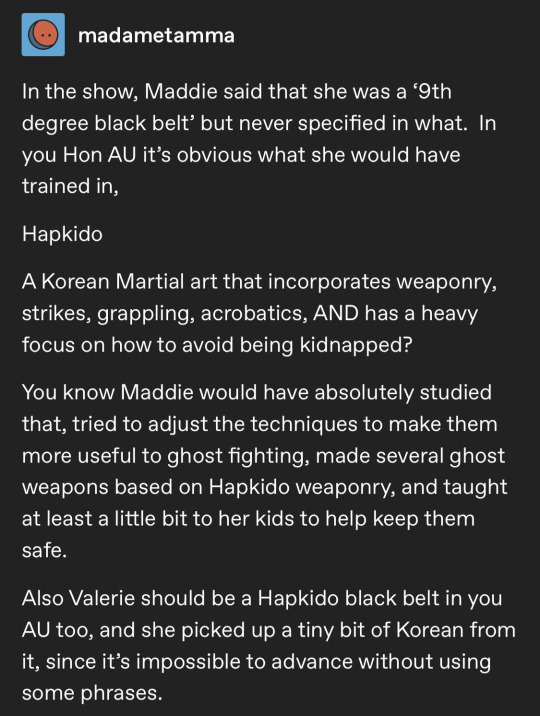
@madametamma OHHHHHH GOOD IDEA
ok ok ok. in the Hon AU danny has no idea who the red huntress is at first
they’ve gotten into a few fights but nothing could ever tip him off as to who he’s pissed off so badly that they wanna rip him apart (human wise anyway)
its only after he and val get closer and eventually start dating. he brings her to meet his parents and maddie immediately takes a liking to her and starts teaching her hapkido. either danny asked since the cujo incident, sam and tuck have ghost weapons but val doesn’t or val asked herself, either way maddie happily agreed
then one of the next run ins with the red huntress danny has to work with avoiding new improvised attacks with hapkido worked in and it hits him like a bag of bricks
“val is the red huntress”
55 notes • Posted 2021-11-11 17:05:33 GMT
#3

@madametamma YEAH THATS EXACTLY WHAT I WAS THINKING WITH A DRUNK JACK. THE SAME BUT EVEN LOUDER
92 notes • Posted 2021-11-04 12:36:50 GMT
#2

@madametamma PLEASE THIS IS SO FUCKING FUNNY
‘jack is not an observant man’ HAHAHAHHAHAHA I CANT EVEN ARGUE THAT HES DOING HIS BEST
DANNY IN SIDNEYS BODY IN THE MIRROR JUST STRAIGHT UP SPEAKING PERFECT KOREAN. OR JUST CALLING THEM BY THE KOREAN NICKNAMES HES GIVEN THEM (aww thatd be sweet actually)
209 notes • Posted 2021-11-02 15:35:03 GMT
#1
the phandom: collectively slapping danny on the back. THIS BABY CAN FIT SO MUCH ANGST IN HIM
234 notes • Posted 2021-11-17 19:03:22 GMT
Get your Tumblr 2021 Year in Review →
#my 2021 tumblr year in review#your tumblr year in review#im not even surprised that all of my top posts are related to danny phantom#AND 3 OF THEM ARE HON AU RELATED HAHAHAHAHA
6 notes
·
View notes